
In 2024, Fun & Easy Masking Tricks in Filmora

Fun & Easy Masking Tricks in Filmora
Masking is a video effect that allows you to cut out a scene and use the overlay to duplicate, hide, modify, or reveal your video footage. Just think of it as cutting something on your video so you can see what’s in the bottom layer. So, without wasting time, let me show you how to mask a video in Wondershare Filmora . Let’s get started!
Free Download For Win 7 or later(64-bit)
Free Download For macOS 10.14 or later
Masking Trick 1:
First, you need to shoot footage to add the masking effect. To do that, find a doorway with enough space to walk back and forth before setting up a camera with a tripod facing the entrance. Make sure you set the camera at the center height of the door to prevent lens distortion.
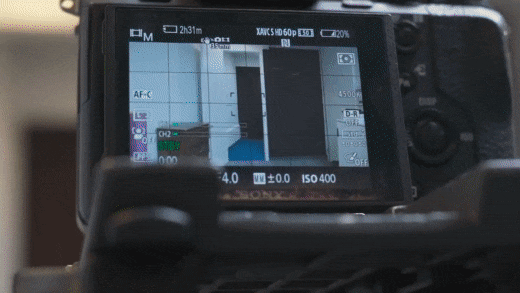
With the tripod set up, film yourself walking behind the door toward the camera. Get close to the camera, then walk back to the door. Then, cross the doorway slowly before walking out of the frame. Now let’s get editing with Wondershare Filmora.
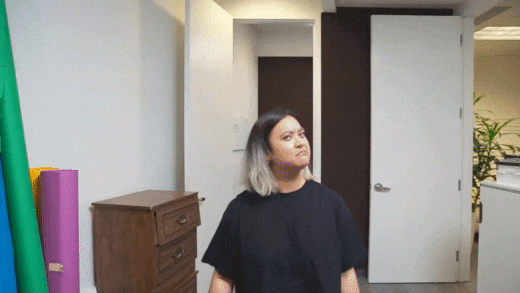
Step 1 Fire up Wondershare Filmora, then import the clip on the video editor. After that, move the clip to the timeline by merely dragging it. Add two clips on the first and second tracks.
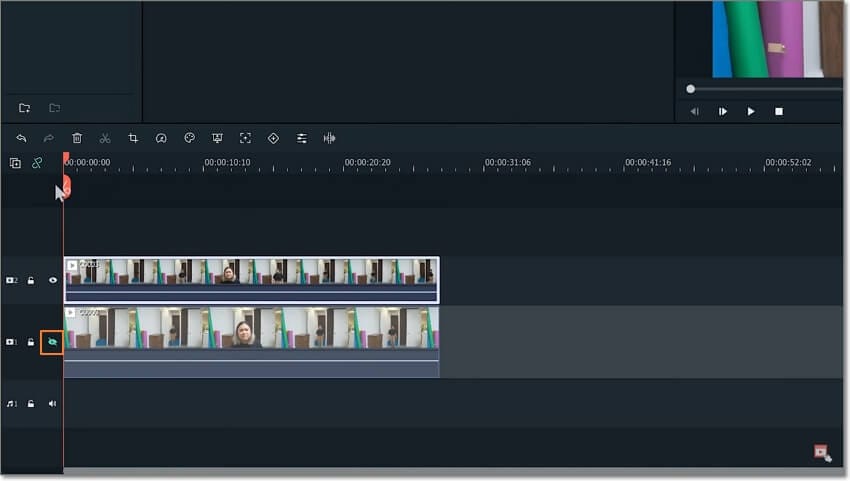
Step 2 Now proceed to hide the first track before adding a freeze frame on the second track. To do that, move the playhead to find the starting scene with the door frame without your subject. Then, right-click the clip and tap Add Freeze Frame. After that, extend the freeze frame area and cut out the rest of the clip.
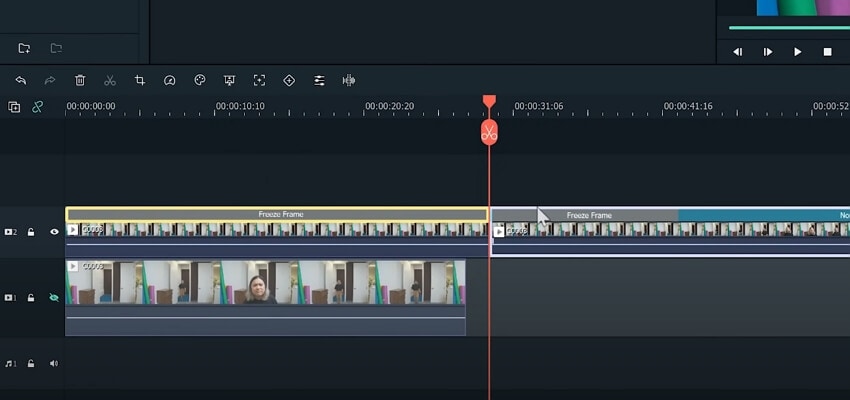
Step 3 Next, click the Effect button and find the Image Mask effect in the Utility folder. Now drag the effect to the top layer.
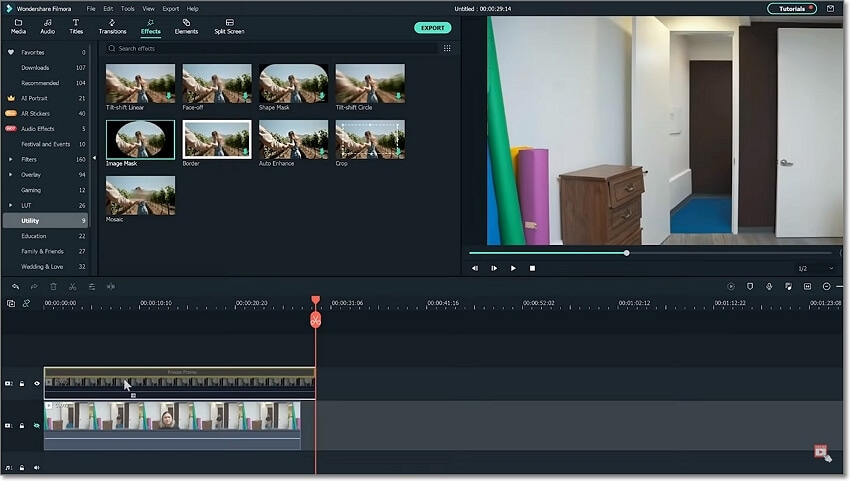
Step 4 Double-click the clip to open the video editing options, then choose a rectangle image mast under Video Effects. Ensure the mask is inverted by clicking the Invert Mask checkbox. Now adjust the mast to match the door frame before clicking Ok.
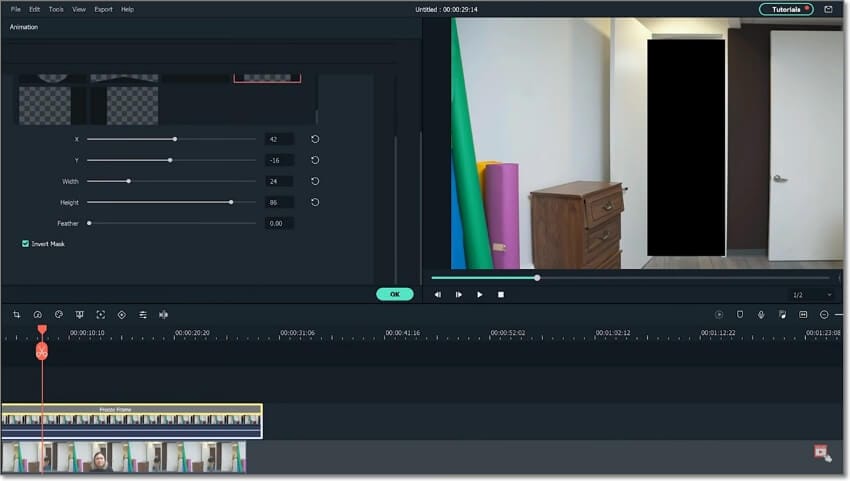
Step 5 Up to this point, unhide the first track, then find the scene where the subject appears on the door frame. On the first track, cut the clip before the subject appears on the stage before cutting the scene where the subject crosses the door frame for the second time on the second track. Now play the video to view your masking effect.

Masking Trick: 2
In the second masking effect, we want to create a subject walking in and outside a tree. To do that, find a tree with a clear background, then place your camera to film the center of the tree trunk where the subject will be walking.
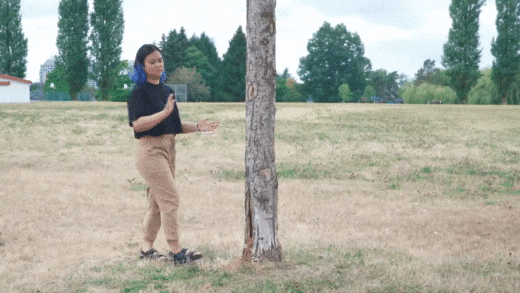
Now film the subject walking from one side of the tree, stop for a second, and then turn back. They should repeat the same action, but this time they’ll walk forward outside the frame after the one-second stop. That’s all!

Step 1 Import the clip on Filmora, then add the footage on the first and second timelines. After that, hide the first track, then find the scene where the subject walks forward away from the tree in the second track. Cut off the area before that action.
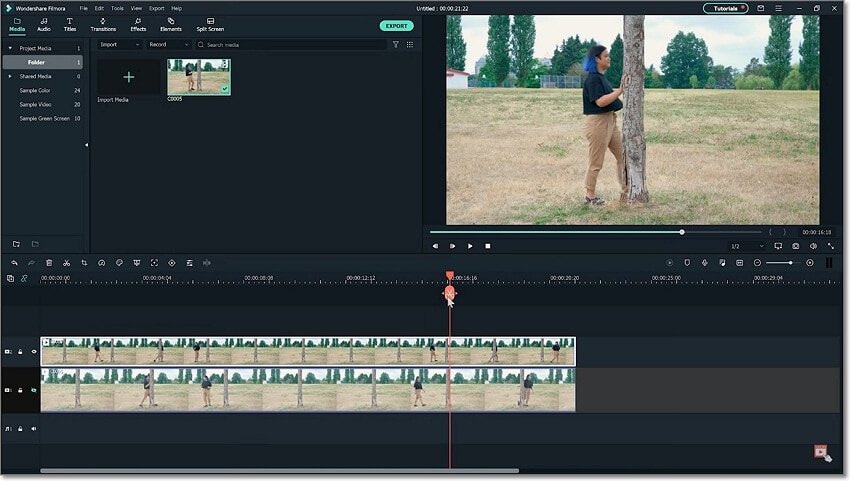
Step 2 Next, click Effects, choose Utility, then drag the Image Mask effect on the second video track. Then, double-click the second clip, select Video Effects, and choose a rectangular option that masks the right side of the frame.
Now adjust the mask until it covers the entire right side of the tree. After that, unhide the first clip and move the second to match the first clip’s timing. You can also cut out everything outside the scene of the first clip.
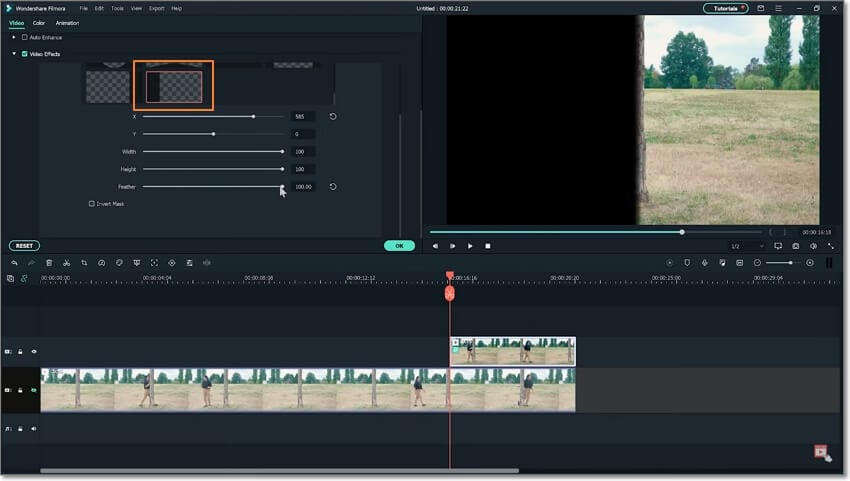
Step 3 Play the video to see your subject walking in both directions of the tree.
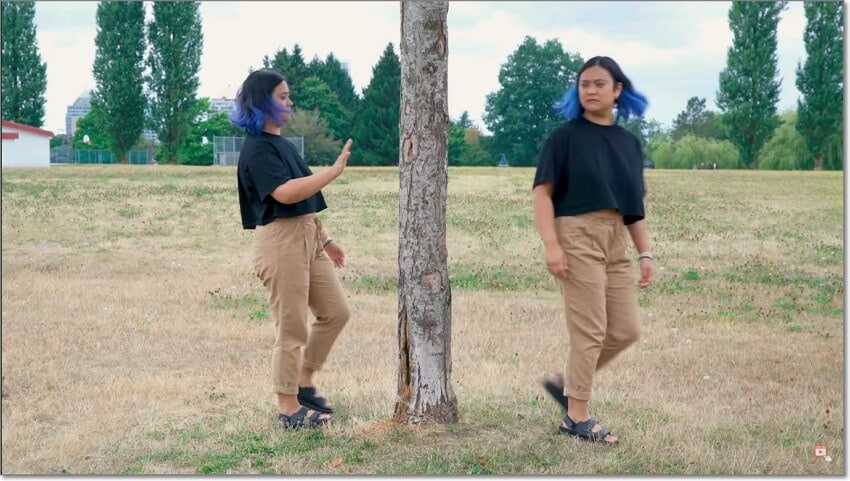
Masking Trick 3:
For this masking illusion, we’ll create a video with a subject jumping over a house. So, set up your camera tripod on a low level in front of the building. You can also add a mark on the ground for your subject to know where to jump.
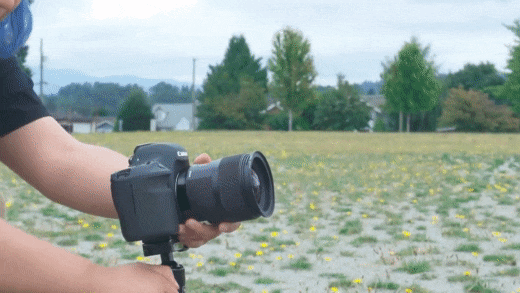
Now tell your subject to walk to the marker before jumping and walking out of the scene.
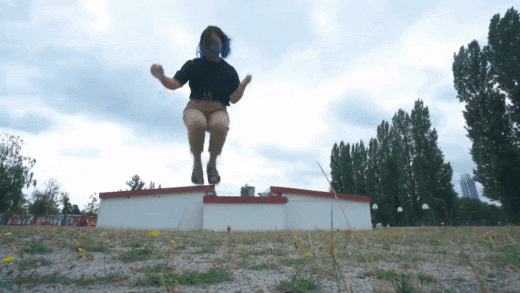
Step 1 Import the clip into Filmora and add it to the first and second tracks. Now hide the first track before finding the scene without the subject in the second track and add a freeze frame. After that, extend the freeze frame area and cut out the rest of the clip.
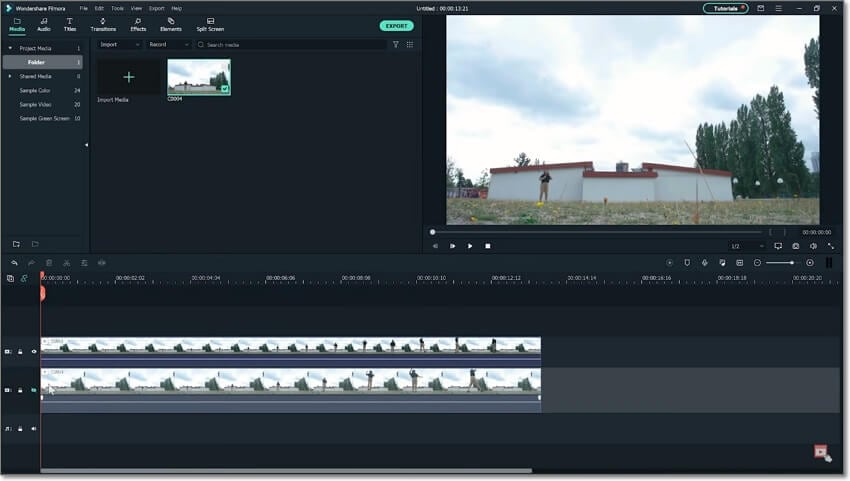
Step 2 Now, it’s time to customize the clip with a mask. To do that, head to the Utility folder under Effects and choose Image Mask. Click the Invert Mask box to invert the mask.
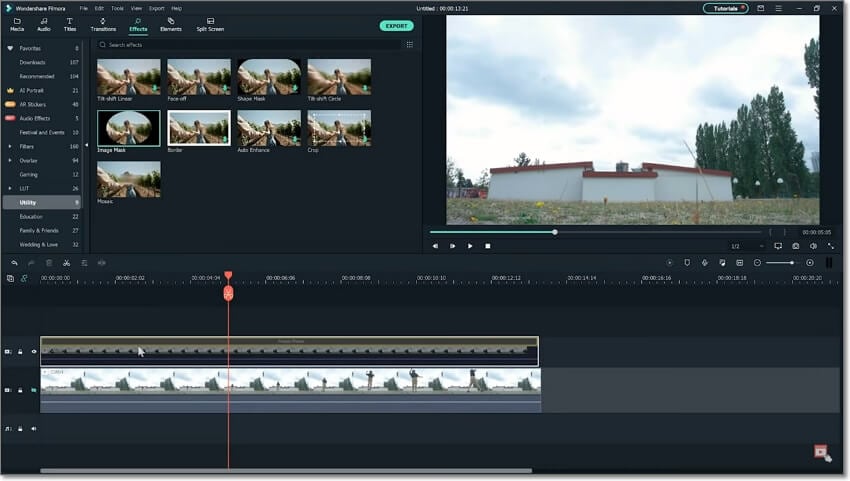
Step 3 Double-click the video track and choose an image mask under Video Effects. Note that you may need several combinations of masks to mask out the sky and leave the building. So, play around with different masking shapes until the sky is covered.
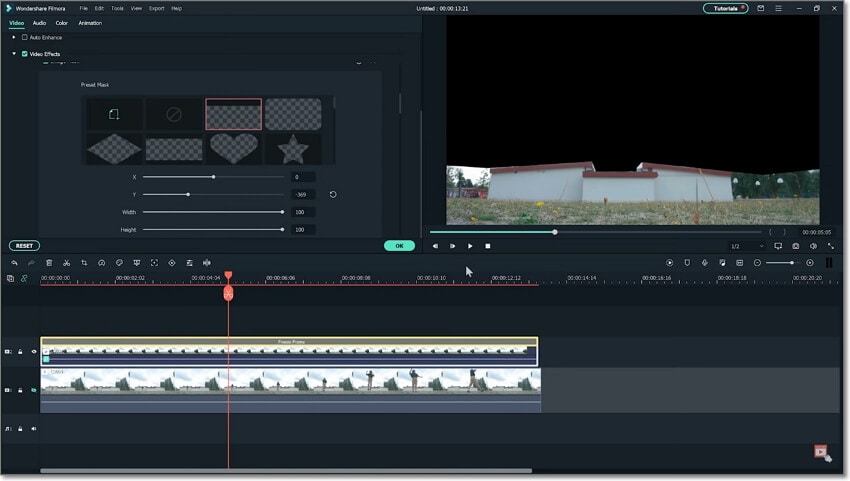
Step 4 After masking, unhide the first track on the timeline before playing the video to find the scene where the subject appears and cut off everything before that scene. Also, find the scene where the subject jumps in the air and cut the clip in the second track. Then, delete everything after that scene.
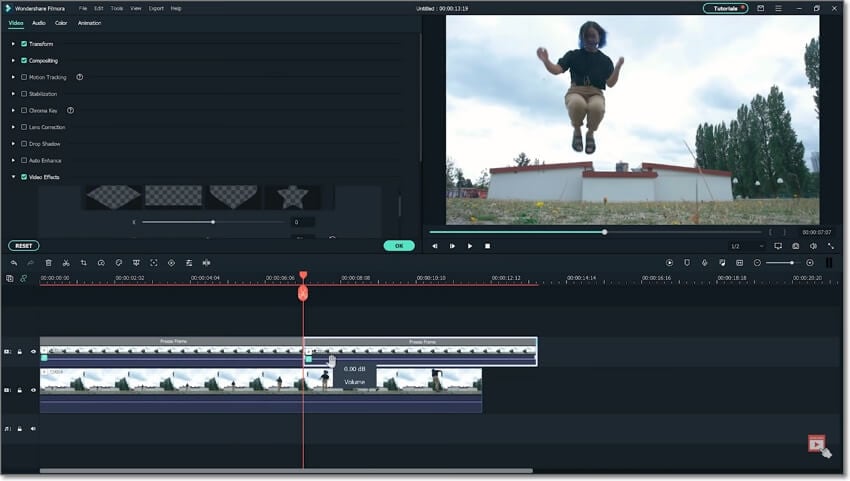
Step 5 Play the video to see your subject jumping over the building and walking away from the scene.
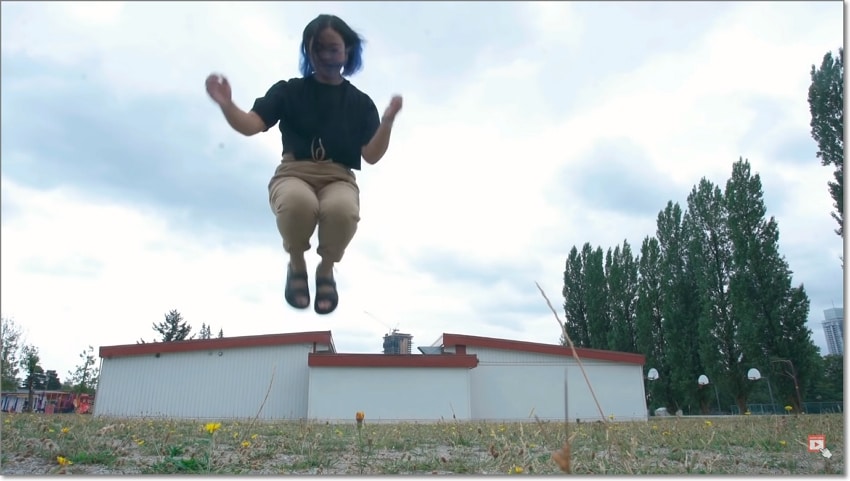
Conclusion
That was easy, right? Playing around with Filmora’s masking tools can create incredible masking illusions like the ones we’ve discussed. And don’t forget this video editor has many more creative possibilities. You should try these masking tricks!
Free Download For macOS 10.14 or later
Masking Trick 1:
First, you need to shoot footage to add the masking effect. To do that, find a doorway with enough space to walk back and forth before setting up a camera with a tripod facing the entrance. Make sure you set the camera at the center height of the door to prevent lens distortion.

With the tripod set up, film yourself walking behind the door toward the camera. Get close to the camera, then walk back to the door. Then, cross the doorway slowly before walking out of the frame. Now let’s get editing with Wondershare Filmora.

Step 1 Fire up Wondershare Filmora, then import the clip on the video editor. After that, move the clip to the timeline by merely dragging it. Add two clips on the first and second tracks.

Step 2 Now proceed to hide the first track before adding a freeze frame on the second track. To do that, move the playhead to find the starting scene with the door frame without your subject. Then, right-click the clip and tap Add Freeze Frame. After that, extend the freeze frame area and cut out the rest of the clip.

Step 3 Next, click the Effect button and find the Image Mask effect in the Utility folder. Now drag the effect to the top layer.

Step 4 Double-click the clip to open the video editing options, then choose a rectangle image mast under Video Effects. Ensure the mask is inverted by clicking the Invert Mask checkbox. Now adjust the mast to match the door frame before clicking Ok.

Step 5 Up to this point, unhide the first track, then find the scene where the subject appears on the door frame. On the first track, cut the clip before the subject appears on the stage before cutting the scene where the subject crosses the door frame for the second time on the second track. Now play the video to view your masking effect.

Masking Trick: 2
In the second masking effect, we want to create a subject walking in and outside a tree. To do that, find a tree with a clear background, then place your camera to film the center of the tree trunk where the subject will be walking.

Now film the subject walking from one side of the tree, stop for a second, and then turn back. They should repeat the same action, but this time they’ll walk forward outside the frame after the one-second stop. That’s all!

Step 1 Import the clip on Filmora, then add the footage on the first and second timelines. After that, hide the first track, then find the scene where the subject walks forward away from the tree in the second track. Cut off the area before that action.

Step 2 Next, click Effects, choose Utility, then drag the Image Mask effect on the second video track. Then, double-click the second clip, select Video Effects, and choose a rectangular option that masks the right side of the frame.
Now adjust the mask until it covers the entire right side of the tree. After that, unhide the first clip and move the second to match the first clip’s timing. You can also cut out everything outside the scene of the first clip.

Step 3 Play the video to see your subject walking in both directions of the tree.

Masking Trick 3:
For this masking illusion, we’ll create a video with a subject jumping over a house. So, set up your camera tripod on a low level in front of the building. You can also add a mark on the ground for your subject to know where to jump.

Now tell your subject to walk to the marker before jumping and walking out of the scene.

Step 1 Import the clip into Filmora and add it to the first and second tracks. Now hide the first track before finding the scene without the subject in the second track and add a freeze frame. After that, extend the freeze frame area and cut out the rest of the clip.

Step 2 Now, it’s time to customize the clip with a mask. To do that, head to the Utility folder under Effects and choose Image Mask. Click the Invert Mask box to invert the mask.

Step 3 Double-click the video track and choose an image mask under Video Effects. Note that you may need several combinations of masks to mask out the sky and leave the building. So, play around with different masking shapes until the sky is covered.

Step 4 After masking, unhide the first track on the timeline before playing the video to find the scene where the subject appears and cut off everything before that scene. Also, find the scene where the subject jumps in the air and cut the clip in the second track. Then, delete everything after that scene.

Step 5 Play the video to see your subject jumping over the building and walking away from the scene.

Conclusion
That was easy, right? Playing around with Filmora’s masking tools can create incredible masking illusions like the ones we’ve discussed. And don’t forget this video editor has many more creative possibilities. You should try these masking tricks!
Free Download For macOS 10.14 or later
Masking Trick 1:
First, you need to shoot footage to add the masking effect. To do that, find a doorway with enough space to walk back and forth before setting up a camera with a tripod facing the entrance. Make sure you set the camera at the center height of the door to prevent lens distortion.

With the tripod set up, film yourself walking behind the door toward the camera. Get close to the camera, then walk back to the door. Then, cross the doorway slowly before walking out of the frame. Now let’s get editing with Wondershare Filmora.

Step 1 Fire up Wondershare Filmora, then import the clip on the video editor. After that, move the clip to the timeline by merely dragging it. Add two clips on the first and second tracks.

Step 2 Now proceed to hide the first track before adding a freeze frame on the second track. To do that, move the playhead to find the starting scene with the door frame without your subject. Then, right-click the clip and tap Add Freeze Frame. After that, extend the freeze frame area and cut out the rest of the clip.

Step 3 Next, click the Effect button and find the Image Mask effect in the Utility folder. Now drag the effect to the top layer.

Step 4 Double-click the clip to open the video editing options, then choose a rectangle image mast under Video Effects. Ensure the mask is inverted by clicking the Invert Mask checkbox. Now adjust the mast to match the door frame before clicking Ok.

Step 5 Up to this point, unhide the first track, then find the scene where the subject appears on the door frame. On the first track, cut the clip before the subject appears on the stage before cutting the scene where the subject crosses the door frame for the second time on the second track. Now play the video to view your masking effect.

Masking Trick: 2
In the second masking effect, we want to create a subject walking in and outside a tree. To do that, find a tree with a clear background, then place your camera to film the center of the tree trunk where the subject will be walking.

Now film the subject walking from one side of the tree, stop for a second, and then turn back. They should repeat the same action, but this time they’ll walk forward outside the frame after the one-second stop. That’s all!

Step 1 Import the clip on Filmora, then add the footage on the first and second timelines. After that, hide the first track, then find the scene where the subject walks forward away from the tree in the second track. Cut off the area before that action.

Step 2 Next, click Effects, choose Utility, then drag the Image Mask effect on the second video track. Then, double-click the second clip, select Video Effects, and choose a rectangular option that masks the right side of the frame.
Now adjust the mask until it covers the entire right side of the tree. After that, unhide the first clip and move the second to match the first clip’s timing. You can also cut out everything outside the scene of the first clip.

Step 3 Play the video to see your subject walking in both directions of the tree.

Masking Trick 3:
For this masking illusion, we’ll create a video with a subject jumping over a house. So, set up your camera tripod on a low level in front of the building. You can also add a mark on the ground for your subject to know where to jump.

Now tell your subject to walk to the marker before jumping and walking out of the scene.

Step 1 Import the clip into Filmora and add it to the first and second tracks. Now hide the first track before finding the scene without the subject in the second track and add a freeze frame. After that, extend the freeze frame area and cut out the rest of the clip.

Step 2 Now, it’s time to customize the clip with a mask. To do that, head to the Utility folder under Effects and choose Image Mask. Click the Invert Mask box to invert the mask.

Step 3 Double-click the video track and choose an image mask under Video Effects. Note that you may need several combinations of masks to mask out the sky and leave the building. So, play around with different masking shapes until the sky is covered.

Step 4 After masking, unhide the first track on the timeline before playing the video to find the scene where the subject appears and cut off everything before that scene. Also, find the scene where the subject jumps in the air and cut the clip in the second track. Then, delete everything after that scene.

Step 5 Play the video to see your subject jumping over the building and walking away from the scene.

Conclusion
That was easy, right? Playing around with Filmora’s masking tools can create incredible masking illusions like the ones we’ve discussed. And don’t forget this video editor has many more creative possibilities. You should try these masking tricks!
Free Download For macOS 10.14 or later
Masking Trick 1:
First, you need to shoot footage to add the masking effect. To do that, find a doorway with enough space to walk back and forth before setting up a camera with a tripod facing the entrance. Make sure you set the camera at the center height of the door to prevent lens distortion.

With the tripod set up, film yourself walking behind the door toward the camera. Get close to the camera, then walk back to the door. Then, cross the doorway slowly before walking out of the frame. Now let’s get editing with Wondershare Filmora.

Step 1 Fire up Wondershare Filmora, then import the clip on the video editor. After that, move the clip to the timeline by merely dragging it. Add two clips on the first and second tracks.

Step 2 Now proceed to hide the first track before adding a freeze frame on the second track. To do that, move the playhead to find the starting scene with the door frame without your subject. Then, right-click the clip and tap Add Freeze Frame. After that, extend the freeze frame area and cut out the rest of the clip.

Step 3 Next, click the Effect button and find the Image Mask effect in the Utility folder. Now drag the effect to the top layer.

Step 4 Double-click the clip to open the video editing options, then choose a rectangle image mast under Video Effects. Ensure the mask is inverted by clicking the Invert Mask checkbox. Now adjust the mast to match the door frame before clicking Ok.

Step 5 Up to this point, unhide the first track, then find the scene where the subject appears on the door frame. On the first track, cut the clip before the subject appears on the stage before cutting the scene where the subject crosses the door frame for the second time on the second track. Now play the video to view your masking effect.

Masking Trick: 2
In the second masking effect, we want to create a subject walking in and outside a tree. To do that, find a tree with a clear background, then place your camera to film the center of the tree trunk where the subject will be walking.

Now film the subject walking from one side of the tree, stop for a second, and then turn back. They should repeat the same action, but this time they’ll walk forward outside the frame after the one-second stop. That’s all!

Step 1 Import the clip on Filmora, then add the footage on the first and second timelines. After that, hide the first track, then find the scene where the subject walks forward away from the tree in the second track. Cut off the area before that action.

Step 2 Next, click Effects, choose Utility, then drag the Image Mask effect on the second video track. Then, double-click the second clip, select Video Effects, and choose a rectangular option that masks the right side of the frame.
Now adjust the mask until it covers the entire right side of the tree. After that, unhide the first clip and move the second to match the first clip’s timing. You can also cut out everything outside the scene of the first clip.

Step 3 Play the video to see your subject walking in both directions of the tree.

Masking Trick 3:
For this masking illusion, we’ll create a video with a subject jumping over a house. So, set up your camera tripod on a low level in front of the building. You can also add a mark on the ground for your subject to know where to jump.

Now tell your subject to walk to the marker before jumping and walking out of the scene.

Step 1 Import the clip into Filmora and add it to the first and second tracks. Now hide the first track before finding the scene without the subject in the second track and add a freeze frame. After that, extend the freeze frame area and cut out the rest of the clip.

Step 2 Now, it’s time to customize the clip with a mask. To do that, head to the Utility folder under Effects and choose Image Mask. Click the Invert Mask box to invert the mask.

Step 3 Double-click the video track and choose an image mask under Video Effects. Note that you may need several combinations of masks to mask out the sky and leave the building. So, play around with different masking shapes until the sky is covered.

Step 4 After masking, unhide the first track on the timeline before playing the video to find the scene where the subject appears and cut off everything before that scene. Also, find the scene where the subject jumps in the air and cut the clip in the second track. Then, delete everything after that scene.

Step 5 Play the video to see your subject jumping over the building and walking away from the scene.

Conclusion
That was easy, right? Playing around with Filmora’s masking tools can create incredible masking illusions like the ones we’ve discussed. And don’t forget this video editor has many more creative possibilities. You should try these masking tricks!
Guide to Making Cinematography for Music Video
To visually represent the story in the music video, cinematography shots are helpful. It’ll obviously and pleasing and eye-catchy effect in your video. These major requirements for making that cinematography can be covered as the following:
- Light a subject
- Create atmosphere
- Light a set
- Camera techniques
- Aspect ratio
- Framing
- Camera movement
Before, we go deeper to the details on how to make a cinematography for music, let us know first about the cinematography for music video. Everything is represented in this article, from the camera movement to the setting of the lights in the studio. You will also learn about aspect ratio and framing while making shots from the DSLR.
What Is Cinematography?
Cinematography covers all aspects of how a movie or music video is made, including choosing the lighting for the scene. The type of camera equipment to use, how to frame your photographs, and how to decide on camera movement are also included in this. Let’s move toward the next lines to get the cool cinematography on display.
Light a subject
Although you may assume that cinematography is just concerned with the usage of the camera, lighting plays an equally important role. While planning your photographs, you should think about how the scene is lit and how your subject is illuminated.

The cinematographer should consider the hard and soft lights for perfect illustrations during shooting. These are depicted with the following requirements!
Hard light and soft light
The cinematographers mainly focus on the hard and soft lights during filmmaking. The hard lights give a softer look to the subject. They are pointing to the light sources which are closer to the subject in the video. It makes the photographs and shots harsher and more dramatic.

The soft light is trying to wrap around the subject. It gives diffused shadows and soft edges to the character of the music video.

![]()
Note: To get better results of the soft look, you need to add diffusion to lower the intensity.
Create Atmosphere
You need a haze machine to create the atmosphere and give the environment true vibes. The haze machine gives a foggy appearance in every shoot and scene.

Filmora Video Editor Easily create video with plenty of video effects and filters.
Free Download Free Download Learn More

Light a Set
To give proper lights in the set is illustrated with the help of an example as shown below!
Examples
In this music video of the 3lau’s, the main prop used is a bus, which is presented in the middle of the set and lit very well. The bus is rounded by many tungsten lights, which give a resemblance to those street lights. They are set up automatically in such a way that this stimulates the real movement of the bus on the road.

The three projectors are set to give the street footage at the back scene to add more realism.
The three lights are set in the queue by the production team to get the memory of the protagonist. In the setup, soft lights are also added on top of all the upper windows of the bus to give blue interior light to the bus.
Camera Techniques
The cameras used during filming play a major role in giving the cinematographic shots. All the techniques shown below are applied to the DSLRs and even the smartphones you use for filming.
Prime lenses
The foremost and most helpful lenses in filming are called prime lenses, which have fixed focal lengths. There is no Johns to zoom out and zoom-in in prime lenses.
For filming, we need to choose the right level of zoom, which the DP does by picking the right lens for the footage.

In the close-up scenes, there is a requirement for a wider field of view which also depends on the aspect ratio of shooting.
Aspect Ratio
In filmy view, the most appropriate aspect ratio is 2.35, which is also a cinematic ratio. There is also another ratio of 16:9, which is a wider ratio. While 2.35 gives a more narrow perspective as compared to the prior one.
![]()
Note: The narrow ratio is helpful in showing the relationships between the subjects.

Whenever we use a microscope, we are dealing with the aspect ratio and narrowing down to the required point where we want to look, and this is all about framing, which is discussed as shown below!
Framing
Framing is a way used to illustrate the concepts such as the rule of thirds and leading lines. To give customized headroom to the subject, the framing is used from the top of the head and the top of the frame.
Camera Movement
The camera movement actually shows the real story presented in the music video. The camera movements used for filming are mainly the pedestal, truck, pan, tilt, and roll.

Whenever the protagonist looks out the bus’s window, the camera operator will use the “Dolly” and “Trucking” movements.
Trucking Movement
The trucking movement of the camera is done in left-to-right motion in the filming. This is used for emotional purposes and whenever the subject is in a pull-out shot.
Dolly Movement
The dolly movement of the camera is done by moving towards or away from the subject. This often gives a sense of importance to the character.
Final Words
The above article gives the exact preferences of the “Tokyo” song by which you learned a lot of techniques for your future use. By following the above rules and tips, you’ll obviously come up with a viral music video.
Create Atmosphere
You need a haze machine to create the atmosphere and give the environment true vibes. The haze machine gives a foggy appearance in every shoot and scene.

Filmora Video Editor Easily create video with plenty of video effects and filters.
Free Download Free Download Learn More

Light a Set
To give proper lights in the set is illustrated with the help of an example as shown below!
Examples
In this music video of the 3lau’s, the main prop used is a bus, which is presented in the middle of the set and lit very well. The bus is rounded by many tungsten lights, which give a resemblance to those street lights. They are set up automatically in such a way that this stimulates the real movement of the bus on the road.

The three projectors are set to give the street footage at the back scene to add more realism.
The three lights are set in the queue by the production team to get the memory of the protagonist. In the setup, soft lights are also added on top of all the upper windows of the bus to give blue interior light to the bus.
Camera Techniques
The cameras used during filming play a major role in giving the cinematographic shots. All the techniques shown below are applied to the DSLRs and even the smartphones you use for filming.
Prime lenses
The foremost and most helpful lenses in filming are called prime lenses, which have fixed focal lengths. There is no Johns to zoom out and zoom-in in prime lenses.
For filming, we need to choose the right level of zoom, which the DP does by picking the right lens for the footage.

In the close-up scenes, there is a requirement for a wider field of view which also depends on the aspect ratio of shooting.
Aspect Ratio
In filmy view, the most appropriate aspect ratio is 2.35, which is also a cinematic ratio. There is also another ratio of 16:9, which is a wider ratio. While 2.35 gives a more narrow perspective as compared to the prior one.
![]()
Note: The narrow ratio is helpful in showing the relationships between the subjects.

Whenever we use a microscope, we are dealing with the aspect ratio and narrowing down to the required point where we want to look, and this is all about framing, which is discussed as shown below!
Framing
Framing is a way used to illustrate the concepts such as the rule of thirds and leading lines. To give customized headroom to the subject, the framing is used from the top of the head and the top of the frame.
Camera Movement
The camera movement actually shows the real story presented in the music video. The camera movements used for filming are mainly the pedestal, truck, pan, tilt, and roll.

Whenever the protagonist looks out the bus’s window, the camera operator will use the “Dolly” and “Trucking” movements.
Trucking Movement
The trucking movement of the camera is done in left-to-right motion in the filming. This is used for emotional purposes and whenever the subject is in a pull-out shot.
Dolly Movement
The dolly movement of the camera is done by moving towards or away from the subject. This often gives a sense of importance to the character.
Final Words
The above article gives the exact preferences of the “Tokyo” song by which you learned a lot of techniques for your future use. By following the above rules and tips, you’ll obviously come up with a viral music video.
How to Use Renderforest Intro Video Maker
When individuals hear about free online items, they frequently associate them with being of poor quality, ineffective, or unreliable. Renderforest, on the other hand, is an exception. This can be precisely what you need if you’re seeking a cheap—or even free—high-quality online video editing platform. The service offers both freemium and premium solutions. The more expensive solutions provide the most flexibility.
What is Renderforest?
A free online tool for making animated videos and slideshows is Renderforest. The web platform makes it simple, quick, and affordable for organizations and individuals to produce slideshows, explainer and promotional business movies, logo animations, and much more.
The online video creation platform Renderforest enables people and companies to produce “broadcast grade” videos for personal or professional usage. Anyone may register as a user in just a few easy steps, and using it is free.
Users can produce an infinite number of high-quality videos, export them, and then share them online or on social media.
The web platform already provides various tailor-made options for blog animations, wedding and photo slideshows, instructional films, and video invites for personal use.
Additionally, the platform offers simple-to-use alternatives for company presentations, invites to events, promotional films, kinetic typography, explainer videos, testimonials, and more.
Renderforest’s Primary Attributes include:
- Videos of high quality
- A sizable collection of animation templates and storylines
- Access to more than 195,000 Royalty-free stock footage clips with an intuitive online movie editor
- One-click video publishing to YouTube channels or Facebook pages
- A music library with commercial licenses for use in making videos
Added characteristics:
- A voiceover generator for text
- Create an infinite number of color schemes
- Countless font uploads
- Obtainable 1,000,000+ premium video templates
- Including a custom watermark
- A reseller’s permit
- Working in teams
How it Works
Choose a video template from their selection by browsing. Once you register, you can utilize any of the hundreds of editable templates that they have available.
You will be presented with various categories when you choose video templates, from promotional templates to logo animation templates to slide displays and everything in between.
You may freely post high-quality photographs, audio, and voice-over, an incredibly fantastic feature. The ability to share their tales in a way that customers can relate to is given to business owners by this.
After you’ve finished editing, the video must render for a while before it’s prepared for publishing. Click the edit button if you want to make some changes to the video or are unsatisfied with it. The video can be edited as many times as you like.
Users can directly post their videos on social media platforms, including Facebook, Twitter, Google+, Pinterest, and Instagram, through the website.
Renderforest maintains all your projects on your dashboard for as long as you use the service, so you don’t have to fear that you’ll lose your work..
Pricing
Regarding costs, Renderforest provides four different kinds of subscription options. The Free, Amateur, Pro, and Business plans are among them. The Free program makes a fantastic study aid. It’s possible to take your time with it, hone your talents, and upgrade to the paid plans after becoming familiar with the platform.
Regarding the free plan, you may watch and share your films on social media but not download them. You must utilize one of the paying subscriptions to download your videos. Choose the Business package if you don’t want Renderforest’s watermark to appear on your video. If you select monthly billing, it will cost you $149.99 per month or $49.99 per year.
If you want to take your company to the next level with distinctive videos, think about selecting one of the expertly produced video production packages. The starting package, which starts at $699, is the least priced.
Tutorial on How to Create an Intro Using Renderforest
Professional video creators are likely aware that starting a video without a suitable introduction is equivalent to sneaking into someone’s house without permission. A good intro is a doorbell to let people know you’ve arrived.
A strong introduction ensures that more people will view your film. Adults have an attention span of about 12 seconds, according to studies from 2000. It is now only 8 seconds. You have 8 seconds to entice viewers to watch your video, so don’t waste it. A captivating introduction will give your content a professional touch and pique your audience’s interest. This task is worthwhile if you want to advertise your videos successfully.
These days, you don’t necessarily need to hire a pro to make a film if you need one. The majority of the available tools are free. We’ll demonstrate in this lesson how to use Renderforest to create a polished video intro. Our intro maker will let you start strong, whether for a fun birthday video or commercial use.
When you’re prepared to begin producing your videos, go to Renderforest, register for an account, or sign in if you already have one.
Check out the vast selection of templates under “Intros and logos“ in the “Create Video“ section of the navigation menu. Here, you can select the intro you like most and begin altering it, or use our advanced search filters to locate the specific content you require.
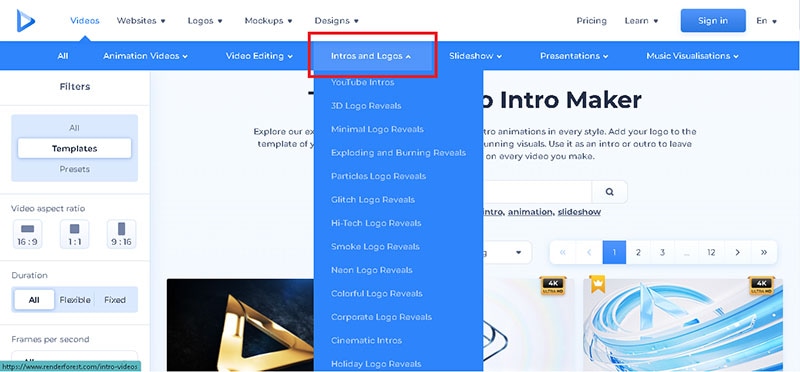
We’ll use the “Swift Glitch Logo“ template for this tutorial, enabling you to present your logo with glitch effects. This template may produce intro and outro movies for presentations, your YouTube channel, lobby backgrounds, and other uses.
Select your preferred template and click the “Create now“ button to start.

Your logo should now be uploaded with a transparent background (PNG). You can upload it in one of three ways: using an image URL directly from your device or selecting an existing file from your “Media library.” If you don’t already have one, you may make one right away using our logo maker tool, which is also accessible in the editor.
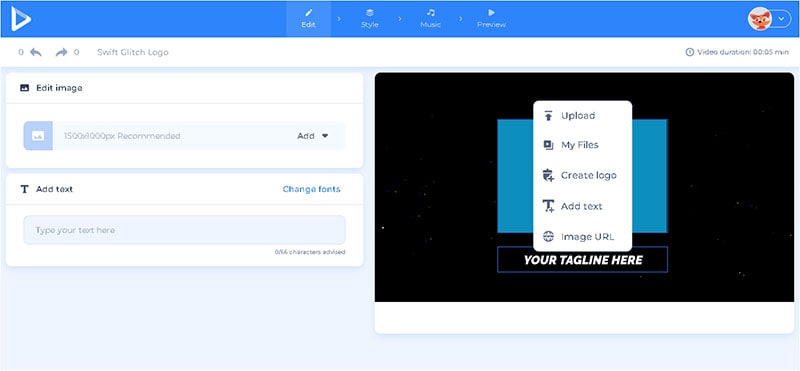
Write your company’s name, tagline, or other brief words in the text field once you’ve added your logo. To save the changes, don’t forget to click “Save and close.”
You can select the overall design of your logo and the preferred font style in the “Style” section.
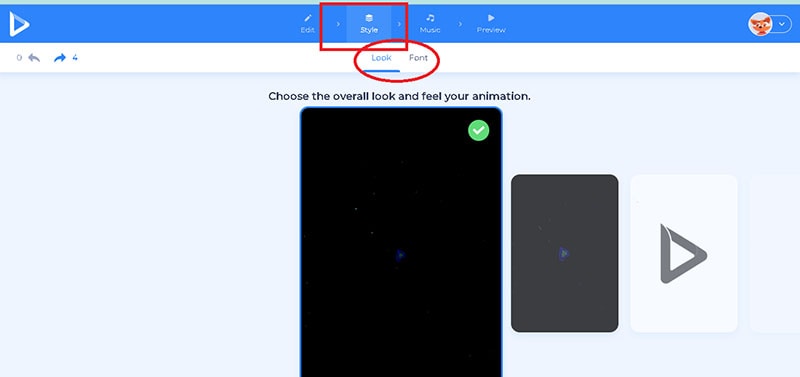
Select your preferred color scheme in the “Color“ section now. You can choose between two color schemes made by our design team and manually selectable custom colors in this section.
Go to the “Music“ area to select a song for your intro. You can add one or pick from our “Music collection.” You can record a voice-over in the editor or upload one for your introduction.
Well done! Let’s check out your introduction in the “Preview“ area now. Click “Free preview“ to check your video and ensure you like the outcome. Click back and tweak the introduction if you need to make any adjustments.
Instantly create professional introduction videos in your browser! Utilize our intro maker, and let its unique touch set your videos apart from the competition.
Enjoy making videos with Renderforest, where your imagination is the only restriction.
Renderforest Pros & Cons
This section is for you if you need to learn quickly about Renderforest’s advantages and disadvantages and are short on time. We’ve studied all the relevant reviews available and created a list of advantages and disadvantages for you to consider.
To determine if this is the best product for your company’s needs, look over these Renderforest advantages and disadvantages.
Pros
- Many lovely and contemporary templates
- a 4K video export feature
- 5-in-1 solution
- use is limitless for all services
- Quick and friendly client support
Cons
- With free version, watermark
- Only paying customers have access to font modification
- Costly single-project packages
- Free high-quality video preview unavailable
- a few templates allow for limited customisation
Competition to Renderforest
Animoto and PowToon are a couple of the site’s main rivals. These are excellent online video editing tools, but Renderforest stands out because it is simple to use and enables even novice users to create, share quickly, and download “broadcast grade videos.”
Renderforest vs PowToon
One of the most popular Renderforest Video alternatives available is PowToon. It’s challenging to decide which of these two platforms is superior because they are the best on the market. What you want as a business owner ultimately determines everything.
PowToon is a similar business that focuses on corporate videos but doesn’t provide the extra things Renderforest delivers (logo maker, graphic design, mockups, website builder). Pro customers pay $89 per month ($20 if invoiced annually), which is significantly more expensive than the alternative. Fortunately, they offer a complimentary bundle so you can sample the goods.
PowToon offers many more customizing choices than Renderforest because it is a video-based platform, but it will cost you.
Renderforest is a more cost-effective option if you need a range of services for your small business. PowToon is a better option for more prominent firms seeking a professional video creation platform.
Currently, some internet video services might be pricey and time-consuming to use. Renderforest will be welcomed by many small businesses looking for an economical and user-friendly online video editing platform.
Renderforest combines the top tools under a single subscription bundle in terms of features. In the end, you can manage your website, branding, and marketing visual production for less than $25 per month.
Fortunately, you don’t have to believe us. You may experience all the main advantages of Renderforest yourself by giving it a try. Check out the pros and drawbacks list in our Renderforest review if you need more assistance.
Free Download For Win 7 or later(64-bit)
Free Download For macOS 10.14 or later
Competition to Renderforest
Animoto and PowToon are a couple of the site’s main rivals. These are excellent online video editing tools, but Renderforest stands out because it is simple to use and enables even novice users to create, share quickly, and download “broadcast grade videos.”
Renderforest vs PowToon
One of the most popular Renderforest Video alternatives available is PowToon. It’s challenging to decide which of these two platforms is superior because they are the best on the market. What you want as a business owner ultimately determines everything.
PowToon is a similar business that focuses on corporate videos but doesn’t provide the extra things Renderforest delivers (logo maker, graphic design, mockups, website builder). Pro customers pay $89 per month ($20 if invoiced annually), which is significantly more expensive than the alternative. Fortunately, they offer a complimentary bundle so you can sample the goods.
PowToon offers many more customizing choices than Renderforest because it is a video-based platform, but it will cost you.
Renderforest is a more cost-effective option if you need a range of services for your small business. PowToon is a better option for more prominent firms seeking a professional video creation platform.
Currently, some internet video services might be pricey and time-consuming to use. Renderforest will be welcomed by many small businesses looking for an economical and user-friendly online video editing platform.
Renderforest combines the top tools under a single subscription bundle in terms of features. In the end, you can manage your website, branding, and marketing visual production for less than $25 per month.
Fortunately, you don’t have to believe us. You may experience all the main advantages of Renderforest yourself by giving it a try. Check out the pros and drawbacks list in our Renderforest review if you need more assistance.
Free Download For Win 7 or later(64-bit)
Free Download For macOS 10.14 or later
Best Audio Plug-Ins For Video Editors
When it comes to improving the sound of the audio in your video editing projects, you have a variety of options to choose from when approaching the editing. Most plugins that we will cover today will be helpful for many different effects instead of only one particular one.
Let’s get started!
1. Synchro Arts Revoice Pro
Let’s talk about Revoice Pro 4. This is an awesome plugin for when you are finishing complex editing projects when you work with dialogues and need to synchronize other lines to fit the shot. Revoice Pro 4 combines timing and pitch alignment technology, together with as a pair of cutting-edge tuning tools and a natural-sounding vocal doubler for people working on the narrator voice.
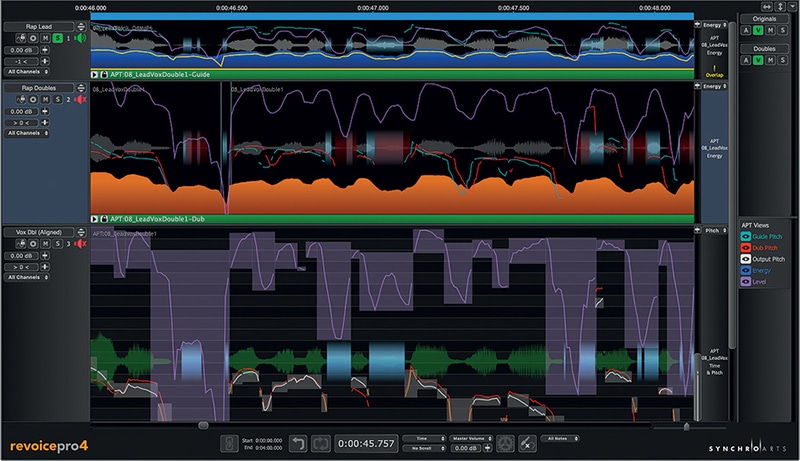
For the video editors working in audio post-production, the stand out new feature added to Revoice Pro is Smart Align combined with a fast workflow, meaning that you don’t need to leave Pro Tools to synchronize ADR to the location audio. Although Version 4.3 presented an ARA version of the Revoice Pro link plug-in for Logic Pro users, so providing immediate transfers back and forth between Logic Pro or higher Synchro Arts haven’t counted out Pro Tools users by preparing a new set of AudioSuite plugins.
The APT procedures, used to align the pitch and timing of multiple vocal tracks, now includes SmartAlign. When this is turned on, it can align audio with significant gaps in the guide or even dub the audio. This feature enables you to align much longer performances, which in the past had to be divided into smaller sections.
As Revoice Pro has improved over the years, the latest version is giving you the ultimate workflow it should always have had in the past. Synchro Arts have been able to create the perfect workflow with an AudioSuite plugin, that runs Revoice Pro in the background without having to have to switch back between Revoice Pro and Pro Tools. Select your audio and the desiredRevoice Pro preset, process the audio in Revoice Pro and place it directly into the timeline without having to leave Pro Tools.
Smart Align and the Quick APT AudioSuite plugin made this fairly easy, yet powerful, workflow. Synchro Arts has also been able to fix the tasks of how to handle gaps. Before V4.3, you had to make sure there weren’t any unexpected empty spots, or it was not able to work out what to do. Using Smart Align, it handles the gaps without any problems.
Whether you need to tighten any kind of pitch or timings on a vocal recording, Revoice Pro is the one for you. Revoice Pro is great for working with vocal recordings, but it’s perfectly suitable for instruments like guitars and strings too.
Synchro Arts Revoice Pro is available for $599.
2. Red Giant Magic Bullet Colorista
This is a very interesting plugin. Colorista tries to cancel out the need for a separate color-specific program by increasing more color correction options. This plugin allows you to have more color control with tools for tints, temperatures, vignetting, RGB curving, and so forth. Colorista contains a three-way color function and support for LOG clips and LUT filters. Colorista is not a stand-alone program. It’s designed to integrate into existing software and offer better functionality. Plugins let you design something that wasn’t there originally. You don’t have to load a certain project to activate them.
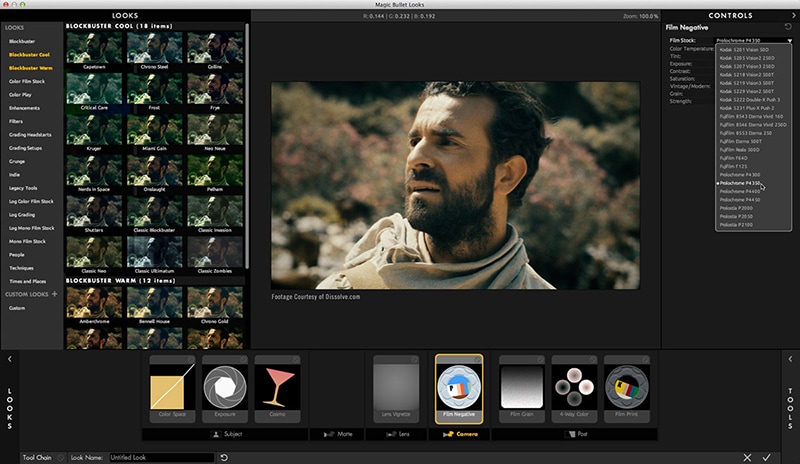
For years, Red Giant has been one of the biggest developers of plugins designed for video editing software. Among the other ones is the Magic bullet suite, which contains quite some plugins to solve video noise problems and do some color grading. We believe the versatility of Red Giant allow content creators and movie producers to let their ideas come to life, create dynamic art and create better content overall.
Even though Red Giant’s Magic Bullet Suite is a plugin suite created for Adobe After Effects and Premiere Pro, it also works with other video editing software such as VEGAS Pro. The suite focuses on color correction and color grading improvements. VEGAS Pro is my software of choice, but one aspect of Premiere that I’ve always thought inadequate were the color correction tools. Looks is completely customizable, and a “preset” can be built up from zero. The Colorista suite comes with a lot of other plugins that have crucial roles in the color grading aspect of video editing. Denoiser II is ideal for clearing up scratchy footage.
Red Giant Magic Bullet Colorista is available for $199.
3. Boris FX Continuum 2022
The thriving film industry’s filmmakers choose Boris FX Continuum. This package contains super strong, timesaving plugins for a smoother workflow with seventeen effects and quick fix plug-in options. Continuum Includes over 200 effects and more than 3500 presets. Each pair will be suitable for each project. Continuum 2022 is the latest biggest release of the post-production plugin collection. The release includes 6 transitions, 4 effects and nearly 100 professionally developed templates. It’s definitely worth checking it out!

This 2022 release brings 50+ film and TV-inspired color grades to assist you in transforming the clips into amazing looks. Included presets like The Wizard of Oz, E.T., Euphoria, and The Grand Budapest Hotel. BCC+Light adds 50+ digital gobos templates to have the overall number of gobos ready to over 700 options.
Boris FX Continuum is available for $495 and $2,195 depending on your payment plan.
Free Download For Win 7 or later(64-bit)
Free Download For macOS 10.14 or later
Also read:
- How to Delete White Background in Photoshop. How to Create a Transparent Background in Photoshop? Steps to Get Rid of White Background in Photoshop
- New In 2024, 10 Best Free Video Player for Windows 11
- Updated 2024 Approved How to Achieve GoPro Slow Motion With Quality
- New Bandicut Video Editor Download and Review for 2024
- If You Are Looking for Reliable Solutions to Export Your Musical Slideshow Through a DVD Burning Process, Take a Breath, You Have Landed at the Right Place for 2024
- Updated In 2024, 2 Methods to Crop a Video in VLC
- Updated Guide Cropping and Combining Content in Wondershare Filmora Latest for 2024
- New How to Create a PowerPoint Looping Slideshow
- New How to Use LUTs in VN Editor – Complete Guide and Best LUTs Download
- Detailed Steps to Rotate Video Using KMPlayer for 2024
- New Best Love Video Maker with Music for 2024
- Updated Top GIF to MP4 Converters
- New 2024 Approved How to Make a GIF With Transparent Background?
- Updated 10 Amazing Anime Character Designs to Inspire You
- How to Change Frame Rate in Premiere Pro for 2024
- In 2024, Top 9 Sparkle Effects Photo and Video Editors You Should Know
- Mask Tracking Is Believed to Be a Helpful Procedure for Marking Proper Areas in Videos. Learn How to Perform Premiere Pro Mask Tracking in This Guide
- Movavi Slideshow Maker Is a Powerful Video Editing Tool that Can Be Used to Add Rich Effects to Videos Easily. This Guide Will Introduce the Features and Show You How to Apply Effects to Videos with This Tool
- Updated 2024 Approved Guide To Creating The Perfect VHS Effect Look in Premiere Pro
- 2024 Approved Unlocking the Power of DaVinci Resolve Scopes Enhance Your Color Grad
- Are You Searching for the Best Canon LUT Download? This Article Provides the Best Recommendations for Creating the Best Professional Videos for 2024
- Want Make a Slide Show Video? Heres How
- Steps to Create Makeup Videos for 2024
- Updated 2024 Approved VN Editor A Prominent Option for Adding Luts for Video Editing
- This Article Is Actually the Guide Regarding Editing the Videos Through VEED. As a Substitute, Wondershare Filmora Is Also Under Discussion that Is Also Available for the Same Purpose
- New 2024 Approved 10 Catchy Pixel Art Wallpapers and How to Custom Your Own
- 2024 Approved Enhance Your Video Color Accuracy with Video Scopes
- Want to Immediately Know Something About Discord GIF?
- Why Your WhatsApp Live Location is Not Updating and How to Fix on your Nokia C210 | Dr.fone
- In 2024, Why is iPogo not working On Vivo V27? Fixed | Dr.fone
- How to retrieve erased messages from Note 30
- In 2024, How to Unlock Your Apple iPhone 6 Plus Passcode 4 Easy Methods (With or Without iTunes)
- Top Apps and Online Tools To Track Vivo S18 Phone With/Without IMEI Number
- In 2024, What Pokémon Evolve with A Dawn Stone For Vivo Y27 5G? | Dr.fone
- In 2024, Top 4 SIM Location Trackers To Easily Find Your Lost Vivo V27 Device
- In 2024, Forgot Pattern Lock? Heres How You Can Unlock Realme 12 5G Pattern Lock Screen
- Easy steps to recover deleted data from Poco X6 Pro
- Top Apps and Online Tools To Track Realme GT 3 Phone With/Without IMEI Number
- Forgot iPhone 14 Plus Backup Password? Heres What to Do | Dr.fone
- What is Fake GPS Location Pro and Is It Good On Xiaomi Redmi K70? | Dr.fone
- In 2024, How to Change GPS Location on Motorola Edge+ (2023) Easily & Safely | Dr.fone
- In 2024, How To Erase an iPhone 6 Without Apple ID Password?
- How to Transfer Data from Motorola Edge 40 Neo to BlackBerry | Dr.fone
- Your Account Has Been Disabled in the App Store and iTunes From iPhone XS Max?
- Can You Unlock iPhone 15 Pro After Forgetting the Passcode?
- Hacks to do pokemon go trainer battles For OnePlus Nord 3 5G | Dr.fone
- In 2024, Mastering Android Device Manager The Ultimate Guide to Unlocking Your Xiaomi Redmi 13C Device
- Authentication Error Occurred on Nokia C210? Here Are 10 Proven Fixes | Dr.fone
- Forgotten The Voicemail Password Of Vivo Y27 5G? Try These Fixes
- How To Change Your SIM PIN Code on Your Infinix Smart 8 Pro Phone
- Still Using Pattern Locks with Realme C33 2023? Tips, Tricks and Helpful Advice
- How to Unlock Xiaomi Redmi Note 12T Pro Phone without Any Data Loss
- Title: In 2024, Fun & Easy Masking Tricks in Filmora
- Author: Chloe
- Created at : 2024-06-09 16:15:30
- Updated at : 2024-06-10 16:15:30
- Link: https://ai-editing-video.techidaily.com/in-2024-fun-and-easy-masking-tricks-in-filmora/
- License: This work is licensed under CC BY-NC-SA 4.0.


